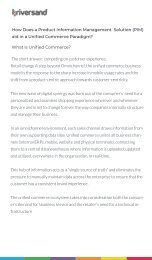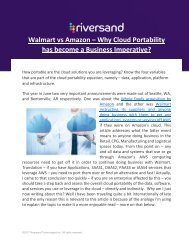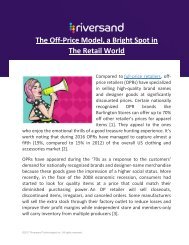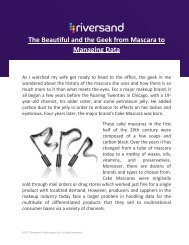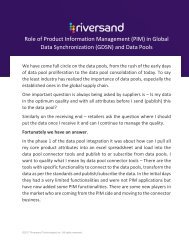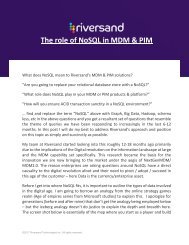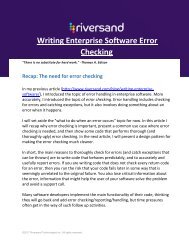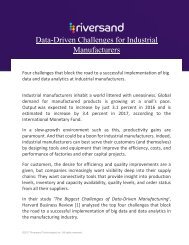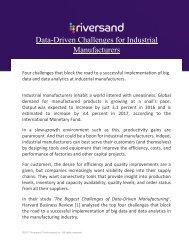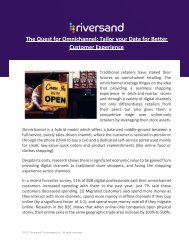Bringing Global Business Complexities into Cloud-Scale MDM-PIM Solutions
Create successful ePaper yourself
Turn your PDF publications into a flip-book with our unique Google optimized e-Paper software.
<strong>Bringing</strong> <strong>Global</strong> <strong>Complexities</strong> to<br />
<strong>Cloud</strong>-based <strong>MDM</strong>/<strong>PIM</strong> <strong>Solutions</strong><br />
As retailers grow managing data across their application landscape becomes central. <strong>Business</strong> users and<br />
Information Technology (IT) leaders want to choose Data Management <strong>Solutions</strong> which provide insights to them<br />
and provide relevant information to their customers along their purchasing lifecycle. Accommodating scale, speed<br />
and different data types requires Data Management <strong>Solutions</strong> to evolve.<br />
How are enterprises coping with scale and flexibility?<br />
Enterprise software solutions are going through a revolution to accommodate scale and<br />
flexibility. Looking at the growth of AWS and Azure one can imagine how aggressively<br />
enterprises are embracing cloud. AWS grew 54.9% year on year and Microsoft’s Azure is<br />
growth in triple digit over the last five quarters. <strong>Cloud</strong> is growing at the rate of 22% Compound<br />
Annual Growth Rate (CAGR), four times the rate of software spending growth. Flexibility in<br />
operating models (Operational Expense vs. Capital Expense), ease of implementation and cost<br />
savings lure <strong>Business</strong> Leaders towards the cloud. To strike a balance with the legacy on premise<br />
solutions and <strong>Cloud</strong> based business friendly application, enterprises will pursue a hybrid cloud<br />
model.<br />
<strong>Cloud</strong> and Retailers<br />
Compared to other verticals, retail has a lower barrier to adopting cloud. <strong>Cloud</strong> is expected to<br />
grow five-fold in retailing. Couple of other data points which bolster this continued accelerated<br />
growth of cloud-based solutions<br />
Digital commerce platform is growing at 15% CAGR driven by SaaS revenues.<br />
Non-Store retailers reported 12% year on year growth per the US Department of Commerce<br />
Retailers invest in various hybrid cloud-based solutions throughout their enterprise, to provide<br />
their consumers with personalized attention, constant engagement and better experience. The<br />
central focus of in this application landscape is to provide their customers with better<br />
experience and their business users with better user experience along with consistent data, in<br />
particularly when it comes to product data.<br />
Product Information Management Solution<br />
Synchronization of product data across applications and channels is critical for enterprises for<br />
improved efficiencies, faster new product introduction and higher sales. A Product Information<br />
Management (<strong>PIM</strong>) solution provides single source of truth, high quality of product content,<br />
global product taxonomies, aggregation and syndication with internal and external sources.<br />
SUPPLY<br />
SELL<br />
©2017 Riversand Technologies Inc. All rights reserved. 1
<strong>PIM</strong> solutions improve sales by providing the right product for the right customer at the right time, improves<br />
efficiencies by accelerating new product introduction, reduces supply chain costs and identifies bottlenecks<br />
through better reporting. By connecting with data pools, vendor data, marketplaces, eCommerce platforms and<br />
Digital Asset Management solutions, <strong>PIM</strong> solutions connect to the entire application ecosystem and keep all the<br />
business users on the same page with “Trusted Product Data”.<br />
The foundation of this “Trusted Product Data” drives an enterprise towards data-driven and outcome based<br />
operations. In such an ecosystem, data models are defined, product data is mapped to marketplace structures,<br />
outcomes are measured and changes are accommodated on a periodic basis.<br />
Transformation in Product Information Management<br />
As retailers grow (organically or through acquisition), data models needs to be changed, infrastructure needs to<br />
be expanded and global variations need to be consolidated <strong>into</strong> one solution. In addition to strategic topline<br />
growth, changing consumer choices interactions and sentiments force business transformations.<br />
<strong>Business</strong> leaders and IT leaders want to gain insights from the <strong>PIM</strong> solutions and ensure they are providing<br />
relevant information to their customers. They are expecting <strong>PIM</strong> solutions to help them solve the following:<br />
Assortment and Product Intelligence:<br />
Do they have the relevant assortment and products to the respective consumer<br />
segments and what are the consumer’s sentiments?<br />
Channel and Operational Intelligence:<br />
How are the products performing on various channels and what’s the impact of<br />
product data quality on the supply chain costs?<br />
Competitive Intelligence:<br />
Is the competition different by merchandising category, and how is the<br />
merchandise performing compared to the competition?<br />
<strong>Business</strong> users and IT users are looking to accommodate this outside-in looking information <strong>into</strong> their application<br />
ecosystem.<br />
IT teams are finding it challenging to correlate external data to the data management practices internally. They<br />
are looking towards technologies that can provide weighted focus on the right segment of products resulting in<br />
either running out of money or exorbitant costs of data management making it unsustainable.<br />
Merchandising teams curating product content have limited or nonexistent abilities to map or correlate product<br />
content to customer segments, competitors, or sentiment via social channels. Customer Service teams are trying<br />
to analyze and draw insights from customer and market segment analysis and marry them with category specific<br />
context.<br />
Next Generation Solution<br />
To accommodate these master and related data, the current Data Management solutions need to evolve to handle<br />
volume, velocity and variety. These solutions will have to be based on hybrid technology framework involving<br />
SQL, NoSQL, Graph and persist both structured and unstructured data. To provide higher Return of Investment<br />
and lower Total Cost of Ownership to the retailers, such solutions will need to be able to scale in or out with a pay<br />
as go model. Also considering that enterprises will have to continue supporting on premise, private cloud and<br />
public cloud models, <strong>PIM</strong> solutions have to provide all these capabilities both on premise and on the cloud.<br />
Next Generation Data Management <strong>Solutions</strong> will bring global business complexities under one solution that is<br />
web-scale, dynamically configurable and offers the best user experience.<br />
©2017 Riversand Technologies Inc. All rights reserved. 2



